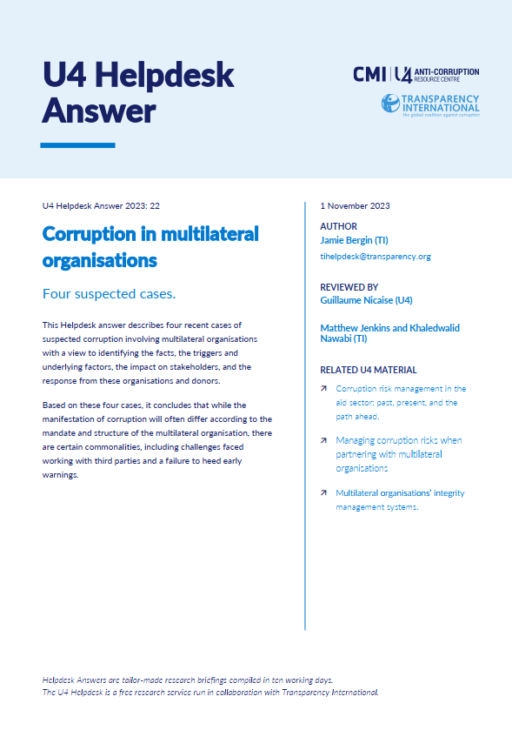
This Anti-Corruption Helpdesk brief was produced in response to a query from a U4 Partner Agency. The U4 Helpdesk is operated by Transparency International in collaboration with the U4 Anti-Corruption Resource Centre based at the Chr. Michelsen Institute.
Query
Please describe suspected cases of corruption involving multilateral organisations.
Summary
This Helpdesk answer describes four recent cases of suspected corruption involving multilateral organisations with a view to identifying the facts, the triggers and underlying factors, the impact on stakeholders, and the response from these organisations and donors.
Based on these four cases, it concludes that while the manifestation of corruption will often differ according to the mandate and structure of the multilateral organisation, there are certain commonalities, including challenges faced working with third parties and a failure to heed early warnings.
Main points
- Most multilateral organisations have established integrity frameworks, anti-corruption policies, and oversight measures. Nonetheless, reports of corruption or misconduct at these organisations continue to emerge.
- Multilateral organisations are generally cautious about disclosing details about specific cases of corruption, and often what information is available in the public domain comes from the work of investigative journalists.
- A review of four suspected cases involving multilateral organisations reveals that a range of forms of corruption can affect their operations, including collusion, bribery and sextortion.
- Triggers and underlying factors can include failure to heed early warnings, risks of working with third parties and challenges in maintaining oversight.
- Corruption involving multilateral organisations can have severe impacts. Not only due to the high sums involved, but also because corruption undermines the intended outcomes of multilateral organisations’ interventions, and these failures can disproportionately impact poor and marginalised populations.
- Responses from donors and multilateral organisations themselves appear to vary depending on the magnitude of the case and the media coverage it receives.
Contents
- Introduction
- UNOPS and S3i initiative (Case #1)
- United Nations Stabilisation Mission in Haiti (Case #2)
- UNHCR resettlement programmes (Case #3)
- World Bank/International Finance Corporation in Guatemala (Case #4)
- Reflections
- References
Caveat
On several occasions, this Helpdesk answer refers to allegations of corruption or misconduct made by third parties but not proven in a court of law. Both Transparency International and U4 keep distance do not take a position on the veracity of the allegations discussed here. They are nonetheless referred to as they illustrate some of the types of corruption risks that multilateral organisations must manage.
For some of the cases described in the paper, investigations and institutional responses are ongoing. The author has attempted to establish the status of the case at the time of writing with reference to information available in the public domain. In this regard, it is important to note that reports and outcomes of internal investigations conducted by multilateral organisations are often kept confidential.
Authors
Jamie Bergin (TI)
Reviewers
Guillaume Nicaise (U4)
Matthew Jenkins and Khaledwalid Nawabi (TI
Date
03/11/2023
Tags
 Download PDF
Download PDF
